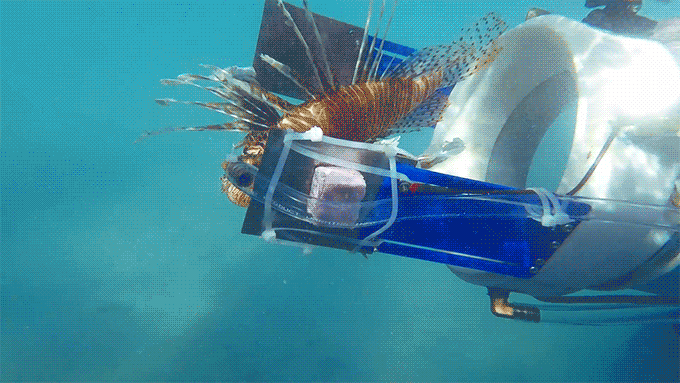Meet the robot submarine that acts as a lionfish predator

This submersible robot, called Guardian LF1, hunts, stuns, and captures lionfish, invasive predators that are threatening native fish and crustaceans in the Atlantic Ocean.
Predator: The Guardian LF1 features eight thrusters, an onboard computer, a camera, and a power source, along with a set of low-voltage “stunning panels” and a chamber for storing captured fish. It is controlled from the surface using a tether but includes an autopilot and a computer vision system capable of distinguishing lionfish from other species.
Prey: Lionfish (more properly known as “pterois”) are native to the Indo-Pacific Ocean, were introduced to the waters off the US several decades ago, and have since spread through the Caribbean and Gulf of Mexico. Without a natural predator, they’ve thrived, wreaking havoc in native ecosystems.
Profit: The robot costs around $1,000 but could net its operator $1,500 to $2,000 worth of lionfish on a good day, its creators claim (assuming the fish can be sold for food). The latest version of the robot can dive to 1,000 feet, below the reach of sport divers. The robot was created by a nonprofit called Robots in Service of the Environment (RSE), founded by Erika Angle and her husband Colin, who is cofounder and CEO of iRobot.
The point: The Guardian LF1 shows how the cost of sensors and advanced algorithms is dropping. iRobot makes a range of successful home robots, including the Roomba robot vacuum cleaners, which themselves have evolved into highly adept navigators. While the first Roombas tootled around blindly, the latest version includes the ability to map its owner's home.
Deep Dive
Artificial intelligence
Large language models can do jaw-dropping things. But nobody knows exactly why.
And that's a problem. Figuring it out is one of the biggest scientific puzzles of our time and a crucial step towards controlling more powerful future models.
Google DeepMind’s new generative model makes Super Mario–like games from scratch
Genie learns how to control games by watching hours and hours of video. It could help train next-gen robots too.
What’s next for generative video
OpenAI's Sora has raised the bar for AI moviemaking. Here are four things to bear in mind as we wrap our heads around what's coming.
Stay connected
Get the latest updates from
MIT Technology Review
Discover special offers, top stories, upcoming events, and more.